Water is your most critical resource after a disaster. After you run through your own backup supply, then what?
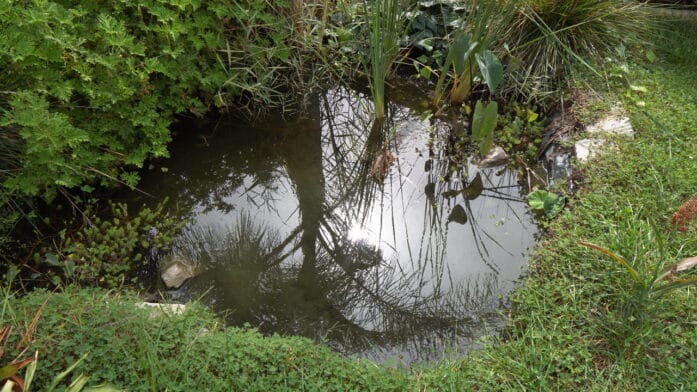
Sure, you can buy a small water filter which is great, but what happens when it breaks or just stops working? I’ve seen a lot of DIY water filtration systems over the years using 5-gallon pails, but before you try building one using that approach, try this smaller, more effective filter.
Here, we will build a more effective water filter that leverages the wisdom of our ancestors to eradicate harmful biological contaminants. After a disaster, if boiling isn’t an option, this should be your go-to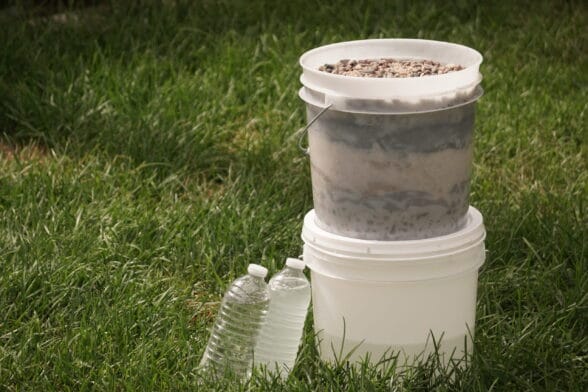 filtration system for up to a month of continual, clean drinking water. We will assume you can’t run to the store to buy things like a spigot, activated charcoal, ceramic filters, silicone, or even reliable power tools. Instead, you can prebuild a filter now for emergency use later using this simple approach.
filtration system for up to a month of continual, clean drinking water. We will assume you can’t run to the store to buy things like a spigot, activated charcoal, ceramic filters, silicone, or even reliable power tools. Instead, you can prebuild a filter now for emergency use later using this simple approach.
What You’ll Need
For this water filtration system, you will need:
- Two 2-gallon food-grade plastic pails with lids.
- Nail, pliers, and fire source.
- A fine cotton cloth like a bed sheet.
For the Filtration Layers:
- Traditional pyrolysis-produced charcoal (we explained how to make this in a recent video which we’ll link to below)
- Fine sand.
- Small pebbles or gravel.
- One or more of these plants for enhance microbial removal: Thyme, Pine Needles and resin, Juniper, Bay Leaves, Eucalyptus, Burdock, Yarrow, Mugwort, Hops, White Willow bark, Neem leaves, Rosemary, or Tulsi (commonly called Holy Basil)
You will need a clear plastic or glass container or bottle for added solar disinfection post-filter.
Steps: As I do each step of this process to build a water filtration system, I will give you the minimum, better, and best practices. What you can do will depend greatly on your situation and resources after a disaster. I will assume you won’t have access to a fancy ceramic filter, but your situation will be slightly better than digging a hole near a creek and drinking straight from the water that fills the hole.
Step 1: Prepare your filtration medium.
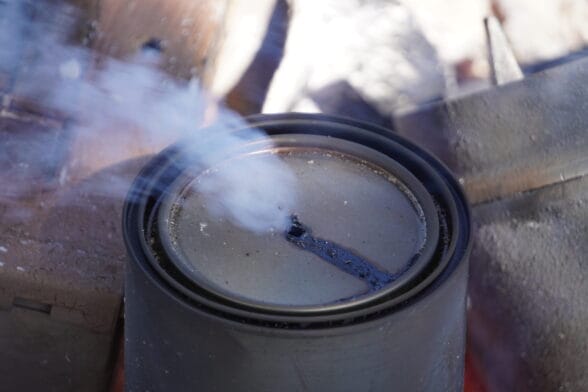 Charcoal: Whether you followed our instructions for making your own charcoal which I’ll link to below, harvested bits of charcoal from unburnt wood in a campfire, or started with non-chemically treated, all-natural charcoal to prepare it for your emergency water filter, you will need to smash it down to smaller pieces. The charcoal you have made yourself is best because you can control the consistency and quality better and know the source of the original biomass used to create it. Store-bought charcoal may not have completed the pyrolysis process. You see, this piece is still mostly wood. That means that it won’t absorb toxins and chemicals well, and it won’t crunch up as we need it to. This can quickly be done with a rock or any blunt object. Powdering is okay, but I find this almost too fine, so I like a little granularity to enhance flow. As I show in the charcoal video, you can get a near-perfect size from hardwood pellets.
Charcoal: Whether you followed our instructions for making your own charcoal which I’ll link to below, harvested bits of charcoal from unburnt wood in a campfire, or started with non-chemically treated, all-natural charcoal to prepare it for your emergency water filter, you will need to smash it down to smaller pieces. The charcoal you have made yourself is best because you can control the consistency and quality better and know the source of the original biomass used to create it. Store-bought charcoal may not have completed the pyrolysis process. You see, this piece is still mostly wood. That means that it won’t absorb toxins and chemicals well, and it won’t crunch up as we need it to. This can quickly be done with a rock or any blunt object. Powdering is okay, but I find this almost too fine, so I like a little granularity to enhance flow. As I show in the charcoal video, you can get a near-perfect size from hardwood pellets.
Charcoal used in water filtration works by adsorbing impurities, including chlorine, organic contaminants, and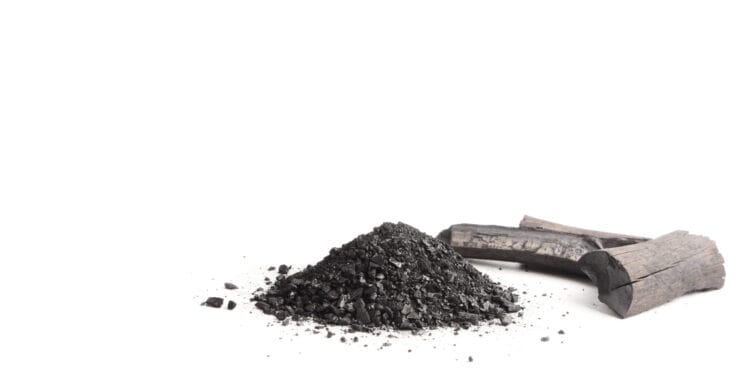 some microorganisms, thus improving taste, reducing odors, and enhancing water quality, but it should not be relied upon as the sole method for disinfecting water with regard to microbial contamination. So, if you have enough charcoal in your filter, you can drink your pool water because it will absorb the chlorine, contaminants, and microorganisms.
some microorganisms, thus improving taste, reducing odors, and enhancing water quality, but it should not be relied upon as the sole method for disinfecting water with regard to microbial contamination. So, if you have enough charcoal in your filter, you can drink your pool water because it will absorb the chlorine, contaminants, and microorganisms.
Sand: When you source sand from the wild, you will pick up all kinds of biological materials, minerals, and heavy metals. If that’s all you have, you must make do with it. In extreme survival situations, people will often dig a hole next to a stream to allow this sand, even as dirty as it is, to filter out what it can. They then drink from the whole as the water filters into it. Our  sand we will wash until the water runs clear. If water isn’t available in large quantities in a post-disaster situation, you can put it in a cloth sack and let a stream run through it, or you can bake it in a pan over a campfire to kill any biological material in it. Just to be extra sure that any biological elements are rendered inert, it’s “better” to dry it in a thin layer in the sun, allowing the sun’s ultraviolet light to kill off microorganisms. It’s best to pasteurize it by heating it in water to at least 140 degrees or higher for 10 minutes or longer. I begin with an excess of sand, which I wash until the water runs mostly or entirely clear, briefly bring to a low simmer, settle, drain, and use the upper layer, leaving about a centimeter untouched on the bottom, as heavy metals are prone to settling at the sand’s bottommost layer. I will heat my sand on the stovetop until it’s at least 140 degrees. This pasteurization will
sand we will wash until the water runs clear. If water isn’t available in large quantities in a post-disaster situation, you can put it in a cloth sack and let a stream run through it, or you can bake it in a pan over a campfire to kill any biological material in it. Just to be extra sure that any biological elements are rendered inert, it’s “better” to dry it in a thin layer in the sun, allowing the sun’s ultraviolet light to kill off microorganisms. It’s best to pasteurize it by heating it in water to at least 140 degrees or higher for 10 minutes or longer. I begin with an excess of sand, which I wash until the water runs mostly or entirely clear, briefly bring to a low simmer, settle, drain, and use the upper layer, leaving about a centimeter untouched on the bottom, as heavy metals are prone to settling at the sand’s bottommost layer. I will heat my sand on the stovetop until it’s at least 140 degrees. This pasteurization will provide me with an inert filtration medium to start with.
provide me with an inert filtration medium to start with.
Sand used as a water filtration medium functions by mechanically trapping suspended particles, promoting the growth of beneficial microorganisms in slow sand filtration, adsorbing some contaminants, and preparing water for disinfection, collectively enhancing water quality and clarity.
Pebbles: The best pebbles to use are solid rocks, pea-sized, which I will wash until clear water flows and heat in the same manner as the sand. This will kill off any microscopic biological material in any pockets or crevices of the pebbles and wash off any dust or powdered minerals on the rock.
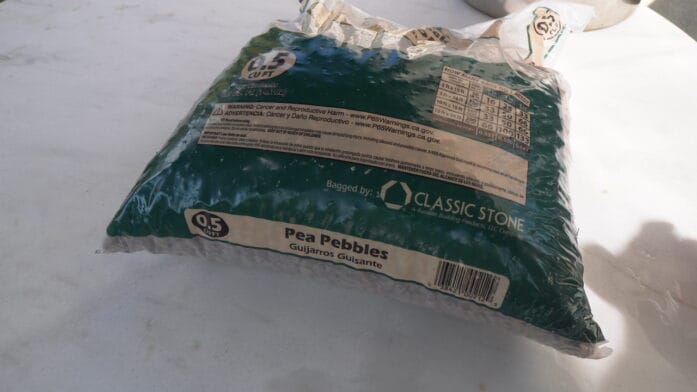 Pebbles, often used as a coarse filtration medium in multi-layer filtration systems, primarily provide mechanical filtration by allowing water to pass through while trapping and removing larger debris, sediment, and some particulate matter, thereby helping to pre-filter the water and prevent clogging of finer filtration layers. A filter that is too dense with sand and charcoal will also drain too slowly or not at all.
Pebbles, often used as a coarse filtration medium in multi-layer filtration systems, primarily provide mechanical filtration by allowing water to pass through while trapping and removing larger debris, sediment, and some particulate matter, thereby helping to pre-filter the water and prevent clogging of finer filtration layers. A filter that is too dense with sand and charcoal will also drain too slowly or not at all.
Cloth: Between filtering materials, we will be using cloth. I will use an old cotton material that I can cut up. You will want to ensure it is old and clean so you don’t have to worry about chemicals or colors being introduced to the water. Over each layer, we will put down a layer of cloth. We will want to ensure it is tight around the sides of our container. You want to ensure there isn’t any leakage and bypass around the cloth.
Cloth, when used as a filtration medium, physically strains out particulate matter, sediment, and larger impurities from water by allowing liquid to pass through while retaining solids, contributing to water clarification and filtration. It will also help to keep your layers separated. I will use cotton, which, in my opinion, is better than synthetic cloth, for this purpose.
Plant Layer: What makes our water filtration better, in my opinion, than what you might find on the internet is the addition of a plant filtration layer. You might ask how all our ancestors drank from wild sources and survived.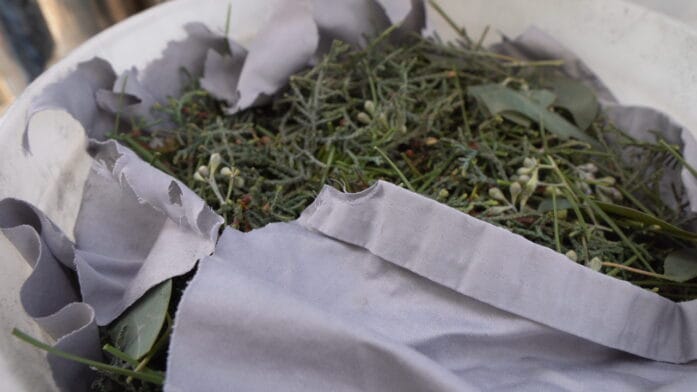 Some didn’t, but they deeply understood nature, even if they didn’t understand the mechanics of microorganisms. Indigenous communities often relied on natural springs, which provided cleaner and safer water sources. Even before pasteurization was scientifically documented, indigenous communities effectively pasteurized water by heating it over a fire, using boiling or heat to kill harmful microorganisms in their water sources. Additionally, they employed natural materials like sand, gravel, and charcoal for filtration, and many cultures utilized plant-based remedies to treat and purify water.
Some didn’t, but they deeply understood nature, even if they didn’t understand the mechanics of microorganisms. Indigenous communities often relied on natural springs, which provided cleaner and safer water sources. Even before pasteurization was scientifically documented, indigenous communities effectively pasteurized water by heating it over a fire, using boiling or heat to kill harmful microorganisms in their water sources. Additionally, they employed natural materials like sand, gravel, and charcoal for filtration, and many cultures utilized plant-based remedies to treat and purify water.
Our plant layer will consist of one or more of these plants for enhanced microbial removal: Thyme, Pine Needles and resin, Juniper, Bay Leaves, Eucalyptus, Burdock, Mugwort, Hops, Willow bark, Moringa seeds, Neem leaves, Rosemary, or Tulsi (commonly called Holy Basil). You could use more types of plants, but the ones I list here are most commonly found and easily identifiable so that you can forage them from nature.
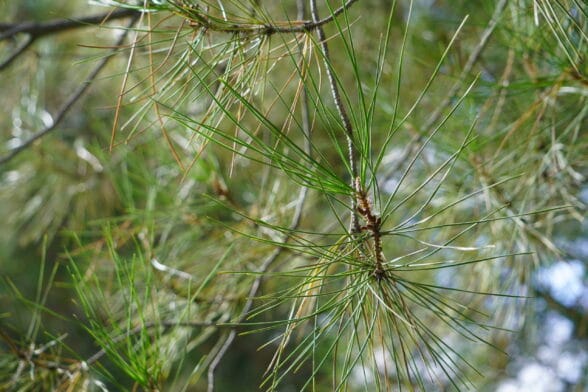 These plants have natural antimicrobial, antifungal, antivirus, and water-purifying properties, which can help inhibit the growth of microorganisms and clarify water by removing impurities. To this day, indigenous people around the world still use Tulsi, Moringa seeds, and some of the other plants mentioned to make water safer to drink. The volatile oils, polyphenols, terpenes, and terpenoids, like those that give Rosemary and Eucalyptus their distinctive aromas, have been studied for their ability to inhibit the growth of bacteria and certain viruses. In our filter, we shouldn’t have to worry about these oils getting into our finished water supply because the charcoal layer should absorb the oils.
These plants have natural antimicrobial, antifungal, antivirus, and water-purifying properties, which can help inhibit the growth of microorganisms and clarify water by removing impurities. To this day, indigenous people around the world still use Tulsi, Moringa seeds, and some of the other plants mentioned to make water safer to drink. The volatile oils, polyphenols, terpenes, and terpenoids, like those that give Rosemary and Eucalyptus their distinctive aromas, have been studied for their ability to inhibit the growth of bacteria and certain viruses. In our filter, we shouldn’t have to worry about these oils getting into our finished water supply because the charcoal layer should absorb the oils.
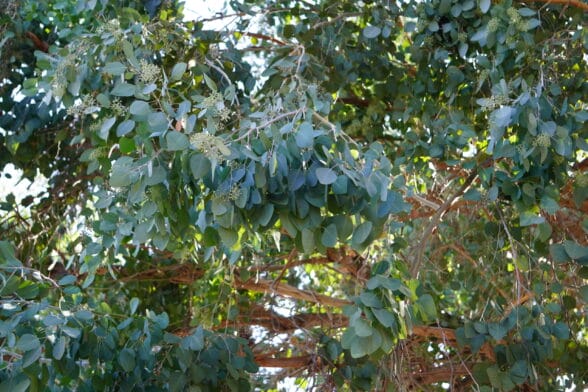
I have foraged some Silver Dollar Eucalyptus leaves and branches, pine needles, some branches, and sap from an Arizona Cypress (any conifer will do), and some Rosemary branches. To prep these, I will soak them to wash off bugs or pollen. When I add them to the filter, I will rough-cut them to increase their release of oils and to allow water to pass through easily. I was very excited to find the cypress sap, and I will just let that mix in with the rest.
Step 2: Constructing The Filter
This will be a one-bucket filter and a one-bucket collection system. Again, I will try to emulate a post-disaster environment where you may not have access to a power drill, grommet, spigot, or silicone. If you have any of those luxuries, you can install a spigot in the bottom bucket to make it easier to access the water.
We will begin by poking holes through the bottom of one bucket and the lid of another. I am building this as if you do not have a power drill, so I will heat a nail as I might in a fire and then poke it through using a set of pliers. I don’t want to use a hammer and nail as that could cause my heavy plastic bucket to split, so I am melting and poking through with this method. Think of this as a clock face and put a series of holes at each of the 12 numbers on the clock face and additional holes around the center. Because the lid has a bit of a lip and the second bucket can be set on top of it, it should filter without spillover. If you have a different setup, you may need to seal around the edge of the lid and the bottom of the bucket with glue, silicone, sap, or clay to keep water from spilling over and being wasted.
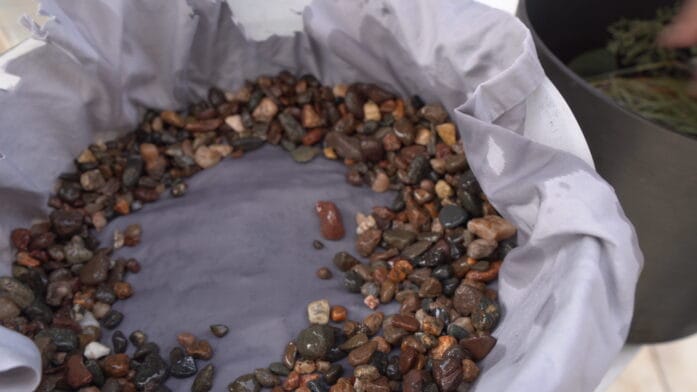 Once you have all your holes, take the bucket with the holes and lay down your first layer of small rocks to a thickness of approximately 2 inches. Next, place a piece of cloth and make sure it goes all the way to the edges of the pail and up the sides. Around the edges, place a thin layer of rocks. This will help to keep it snug and prevent water from leaking around. Now add an approximate 3-inch layer of sand. Then, add another piece of cloth with the same rock rimming.
Once you have all your holes, take the bucket with the holes and lay down your first layer of small rocks to a thickness of approximately 2 inches. Next, place a piece of cloth and make sure it goes all the way to the edges of the pail and up the sides. Around the edges, place a thin layer of rocks. This will help to keep it snug and prevent water from leaking around. Now add an approximate 3-inch layer of sand. Then, add another piece of cloth with the same rock rimming.
On top of that, put approximately 3 inches of your powdered and granulated charcoal. Then, place another layer of cloth with a rock rim. Cut your plant material layer into about 1-inch loose pieces, and add the mix on top. This plant material will also help to repel any new insects or critters who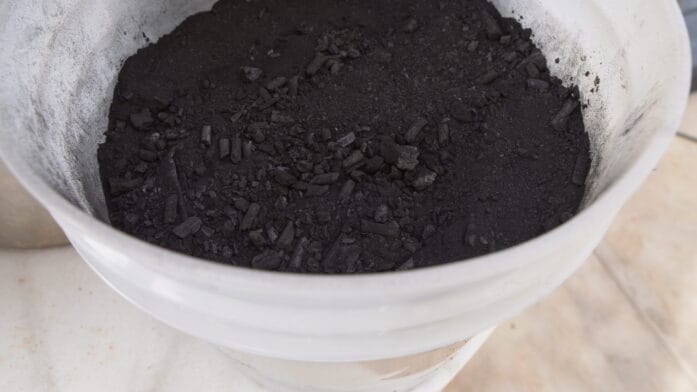 may be drawn by the moisture and will want to make a home in your filter. Then add small rocks and a little sand to within an inch or two of the top of your container. This will allow you a trough to monitor the seepage rate and add water as required. This final layer will filter out large material but is really to weigh all the other contents down.
may be drawn by the moisture and will want to make a home in your filter. Then add small rocks and a little sand to within an inch or two of the top of your container. This will allow you a trough to monitor the seepage rate and add water as required. This final layer will filter out large material but is really to weigh all the other contents down.
Using the Filter
Your first consideration is always how dirty the water is. Is it murky and cloudy, or does it smell? Is it from a pool, a pond, a running stream, rainwater, or floodwater? The filter will be more effective if the water is relatively pure, like collected rainwater. The second consideration is whether you can chemically or solarly treat the water before putting it in your filter. Putting the water in full sunlight for an hour or adding a capful of bleach or hydrogen peroxide will kill off a considerable amount, if not all, of the microorganisms. Just as each layer of your filter is designed to add a layer of protection, pretreatment of your water also adds additional layers of protection.
 Each layer in your filter is intended to reduce biological and chemical contaminants, especially the natural organisms that thrive in water. Bacteria, viruses, fungi, and amoebas can all kill us. The “best” practice is pre-treating your water. This will make your filter’s job easier by reducing or eliminating active organisms.
Each layer in your filter is intended to reduce biological and chemical contaminants, especially the natural organisms that thrive in water. Bacteria, viruses, fungi, and amoebas can all kill us. The “best” practice is pre-treating your water. This will make your filter’s job easier by reducing or eliminating active organisms.
With the filter bucket placed over the empty bucket, use another container to pour water into the filter bucket over time slowly. It should drain slowly into the bottom bucket, and it will take some time. Continue adding dirty water in the top, and when the bottom bucket on the bottom is nearly full, either change it out for a new bucket or scoop the water off. It should be perfectly fine to drink after passing through your filter for all the reasons I have detailed. Still, I’ll add one final layer of protection by scooping the water off into clear plastic or glass bottles and then setting those in the sun for further solar purification.
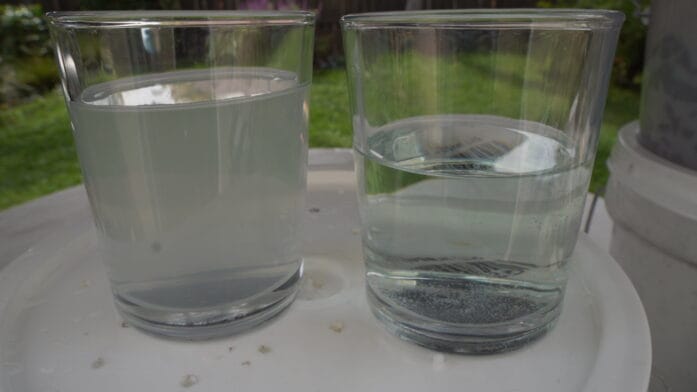 The water will emerge from your filter somewhat cloudy at first, and this is to be expected. Even though we washed all the filtration medium, this process will mineralize the water. That will settle out with time, and the cloudiness will stop as your filtration medium absorbs water and, after it filters a few gallons. You can see that the mineralization and charcoal significantly raised the pH of our finished sample on the left from our starting point on the right of about 7. The original water may have started dirty, but it might now be cleaner than your municipal water source. How long you can use this filter will depend upon how dirty the water
The water will emerge from your filter somewhat cloudy at first, and this is to be expected. Even though we washed all the filtration medium, this process will mineralize the water. That will settle out with time, and the cloudiness will stop as your filtration medium absorbs water and, after it filters a few gallons. You can see that the mineralization and charcoal significantly raised the pH of our finished sample on the left from our starting point on the right of about 7. The original water may have started dirty, but it might now be cleaner than your municipal water source. How long you can use this filter will depend upon how dirty the water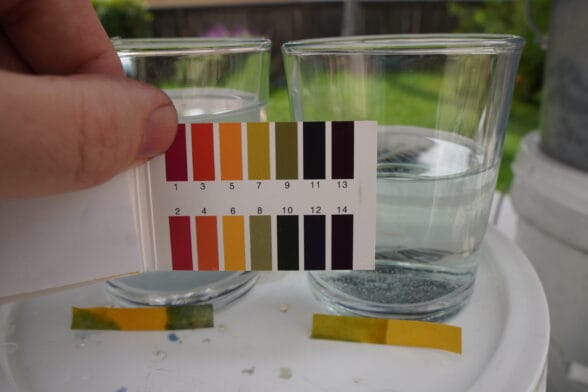 going in is, to begin with. Over time, your filter will collect materials and lose effectiveness. I would dump it in the garden every month and build a new one. The filter materials will enhance and amend your soil.
going in is, to begin with. Over time, your filter will collect materials and lose effectiveness. I would dump it in the garden every month and build a new one. The filter materials will enhance and amend your soil.
Remember, there’s only one rule when it comes to drinking water from the wild– don’t die. A powerful filter like this also adds plant materials for an added microbial protection layer. Take a look at our video on how to make charcoal [LINK] so you know and understand everything to make this filter. You can build this after a disaster from materials you can gather or build a dry filter and put it in your preps so it’s ready to go when needed. This filter leverages the knowledge of ancient people to enhance your survival.
As always, stay safe out there.
LINKS: Making Your Own Charcoal
